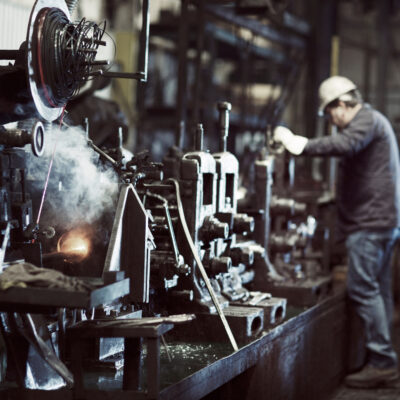
Reshoring strategies can only go so far without investment in America’s skilled workforce.
RECOMMENDED READING
The crisis sparked by the COVID-19 pandemic has brought the hidden costs of offshoring into sharp relief. Our reliance on China for all manner of medical supplies, from antibiotics to personal protective equipment, makes the literal health of American families dependent on the whims of an authoritarian regime.
Drugs and medical devices are just the tip of the iceberg. China is the single largest offshoring destination for U.S.-based multinationals. In manufacturing, U.S. companies employ more workers in China than in Mexico, and own more valuable property, plants, and equipment in China than in any other foreign country besides Canada.1Alexander Hammer, “The Size & Composition of U.S. Manufacturing Offshoring in China,” United States International Trade Commission (USITC) Executive Briefings on Trade (2017). This has led China-U.S. trade to be a global outlier relative to the expectations of the standard “gravity model,” which reliably predicts larger export flows between geographical neighbors. China’s exports to the U.S., in contrast, “are perennially twice as large as predicted.”2Willem Thorbecke, “China-U.S. Trade: A global outlier,” The Research Institute of Economy, Trade and Industry (RIETI)Discussion Paper Series 14-E-039 (2015). What’s going on?
Companies that move operations to China save money through reduced labor costs, but lower wages can only explain so much. The hard truth is that Chinese workers have skills that American workers on the whole lack. This includes an enormous pool of engineering talent with ground-level knowledge of industrial processes, making China a growing hub for research and development, as well. As Apple CEO Tim Cook once put it, “In the U.S. you could have a meeting of tooling engineers, and I’m not sure we could fill the room. In China you could fill multiple football fields.”3As quoted in Samuel Hammond, “The China Shock Doctrine,” National Affairs (Fall 2019).
China’s skilled workforce represents a durable competitive advantage that can’t be easily offset through financial incentives to reshore. Some kinds of knowledge can be written down and easily shared, like a recipe book. Process knowledge, or “know-how,” is much harder to transfer between individuals, let alone whole nations, given its embeddedness in what Brad Delong has called “communities of engineering practice and excellence.” For example, Brazil’s attempt to create a domestic computer industry in the 1970s was a disaster because import-substitution policies prevented Brazilian engineers from learning from engineers in America, while blocking the importation of IBM’s far superior hardware.4“Alphachatterbox: Brad DeLong on Hamiltonian Economics,” Financial Times (May 2016).
Building — or rebuilding — communities of engineering excellence takes time. Acquiring process knowledge requires being a part of the community, whether by recruiting world-class talent from abroad or through trade missions to learn from successful industrial ecosystems. By giving nascent ecosystems enough of a push, the learning-by-doing process can take off in a virtuous cycle that culminates into mastery.5See also Dan Wang, “How Technology Grows (a restatement of definite optimism)” (July 24, 2018). Reshoring strategies based on tax incentives, local content requirements, or R&D investments will only go so far if, at the end of the day, our shiny new factories have “help wanted” signs on the door.
Labor Market Policy Is Industrial Policy
The relationship between labor market policy and industrial policy has wide-ranging implications.6For my personal definition of industrial policy, see “The Struggling Regions Newsletter” (July 9, 2019). Whom and how a nation educates will shape its comparative advantage. Whether labor markets are tight or loose affects investment in labor-saving technology. Whether a company or industry is unionized influences management and production decisions. The ease with which workers can move between jobs affects the diffusion of knowledge between firms. And whether dislocated workers are quickly re-employed after an economic shock determines whether their talents are preserved, enhanced, or allowed to atrophy.
When it comes to an industry’s risk of offshoring, the strength of labor relations matters enormously. As the economist Dani Rodrik has long argued, offshoring (and globalization more generally) increases the own-wage elasticity of labor demand, particularly within the manufacturing sector.7Dani Rodrik, Has Globalization Gone Too Far? (Washington, D.C.: Institute for International Economics, 1997). Stripped of jargon, this simply means that globalization makes employment and wages more responsive to economic shocks, contributing to job insecurity.
“Reshoring strategies based on tax incentives, local content requirements, or R&D investments will only go so far if, at the end of the day, our shiny new factories have ‘help wanted’ signs on the door.”
Conversely, empirical research suggests that stronger employment protections make it more difficult to offshore an industry and therefore decrease the elasticity of labor demand.8Alexander Hijzen and Paul Swaim, “Offshoring, Labour Market Institutions and the Elasticity of Labour Demand,” University of Nottingham Research Paper No. 2008/05 (2008). This can have positive knock-on effects at the industry level. Trade organizations and professional societies can form more easily, helping to preserve process knowledge in a way that transcends any particular firm. Inelastic labor demand can even expand the scope for risk-sharing arrangements, whether through insurance pools or in the form of wages that are stable across time despite fluctuating external conditions.
Indeed, labor relations are key to understanding “why the ‘China Shock’ was so shocking” in the first place, as MIT economist David Autor put it in a 2019 presentation.9David Autor, “Why Was the ‘China Shock’ so Shocking? – And What Does that Mean for Policy?,” Peterson Institute for International Economics (PIIE) (October 17, 2019). Contrary to popular belief, the job losses from Chinese import competition were concentrated not in the so-called Rust Belt, but in the South Atlantic states. The deindustrialization of the Northeast and Midwest began years prior, when manufacturers relocated to the South in droves to take advantage of lower taxes and “Right-to-Work” laws. Weaker labor protections encouraged moving down the value-chain into more labor-intensive forms of production, creating a perfect storm of worker and supply-chain vulnerability.
Why “Active Labor Market Policy”?
Fortunately, capturing the stability benefits of worker protections does not require making it impossible to hire and fire workers. That comes with its own costs. Instead, labor standards can be raised through demand-side policies that keep labor markets tight. While a particular firm may no longer demand a particular worker, a tight labor market ensures the demand for lesser-skilled labor is kept consistently high.
By definition, a tight labor market is one in which job vacancies outnumber jobseekers. Under such conditions, businesses in need of workers must either raise wages, invest in the labor productivity of the workers they already have, or recruit disadvantaged workers from off the sidelines. In the twelve months before COVID-19 wrecked the economy, all three of these effects could be observed in the U.S. thanks to the historically low unemployment rate: Wage growth for the bottom quarter of workers was the fastest in decades, employers were launching training programs for entry-level jobs, and disability rolls were shrinking.
The tight labor market we enjoyed as recently as February was ultimately driven by the business cycle. Eleven years into a recovery, we finally approached full employment. But with quarantines spurring tens of millions of layoffs in the span of a few months, the strong economy turned out to be incredibly fragile.
“While a particular firm may no longer demand a particular worker, a tight labor market ensures the demand for lesser-skilled labor is kept consistently high.”
It didn’t have to be this way. While U.S. unemployment shot up from 3.5% in February to 14.7% in April, Germany’s only rose from 4.7% to 5.5% over the same period.10John Detrixhe, “Why the US unemployment rate is so much higher than Germany’s,” Quartz (May 28, 2020). Their secret? Germany’s Kurzarbeit system of “short-time work” allowed employers to reduce worker hours while the government covered most of their lost wages. In theory, 26 U.S. states have similar work-sharing programs in place, yet uptake is pitiful due to lack of employer outreach, administrative complexity, and employer taxes that discourage its use.11George Wentworth et al., “Lessons Learned: Maximizing the Potential of Work-Sharing in the United States,” National Employment Law Project (NELP) (2014).
Work-sharing programs are just one example of an “active labor market policy” (ALMP). Wage subsidies, job search assistance, or retraining programs are all “active” in the dual sense of activating workers and actively shaping market outcomes, such as the quality of a match between an employer and employee. Work-sharing does this by helping to maintain the employer-employee relationship during a temporary downturn. Unemployment Insurance (UI), in contrast, is considered a “passive” labor market policy because it ostensibly exists to insure individuals against job loss and little more. These distinctions are blurry in practice, as most governments combine active and passive labor market policies in ways that are hard to disentangle.
The United States has incredibly weak labor market policies of either type. According to the OECD, the U.S. spends about 0.10% of GDP on programs that actively encourage labor force participation, the lowest of any OECD country after Mexico.12“Active Labour Market Policies: Connecting People with Jobs,” Organisation for Economic Co-operation and Development (OECD). As the Council of Economic Advisors noted in a 2015 report, our low rate of ALMP spending is the result of a steady erosion that began in the 1980s — an erosion that doesn’t appear to have been a part of any deliberate policy choice, but which correlates well with steady declines in prime-age labor force participation.13“Active Labor Market Policies: Theory and Evidence for What Works,” Council of Economic Advisers Issue Brief (2016).
“Well-designed ALMPs can be both protective of the industries we have and attractive to the industries we might hope to reshore.”
For comparison, Denmark spends over 1.9% of GDP on ALMPs and has perhaps the most dynamic labor market in the world. One in five Danes switch jobs in any given year, aided by insurance with generous wage replacement that transitions into vocational education and other job support programs if workers fail to find a new job quickly.14As discussed in Samuel Hammond, “The Free-Market Welfare State: Preserving dynamism in a volatile world,” Niskanen Center (May 1, 2018). This combination of labor market flexibility, income security, and continuous education is known as “flexicurity” and is the flipside of Denmark’s diversified, export-oriented economy. Roughly 55% of Danish GDP is produced in export industries, of which about a fifth is in manufacturing. International exposure helps to keep the workforce highly productive, but also vulnerable to foreign trade shocks. Robust active labor market programs are thus not simply a nice thing to have, but an integral part of how Denmark stays globally competitive.
Anglophone countries like Canada and Australia expend much less on ALMPs than Scandinavian social democracies, but still double what the U.S. does. In fact, the U.S. would need to increase spending on ALMPs by nearly $100 billion per year just to match the average OECD expenditure of 0.55% of GDP.
The Case for Comprehensive Employment Supports
Well-designed ALMPs can be both protective of the industries we have and attractive to the industries we might hope to reshore. Their effectiveness, however, depends on ensuring that underlying workforce development programs are both comprehensive and administered in coordination with private industry.
America’s largest employment and training program, Trade Adjustment Assistance (TAA), is far from comprehensive. Yet despite its bad reputation, TAA provides valuable resources for workers lucky enough to be admitted, including funding for retraining and income support payments while they are enrolled. According to a quasi-experimental study of 300,000 displaced workers, TAA-trained workers cumulatively earn $50,000 more than their non-TAA trained counterparts over ten years, representing an up to 9% internal rate of return.15Benjamin Hyman, “Can Displaced Labor Be Retrained? Evidence from Quasi-Random Assignment to Trade Adjustment Assistance,” SSRN (April 20, 2018). One third of this effect is driven by higher wages, with the remainder from greater labor force participation, suggesting that workers gain real human capital from retraining.
“All roads to an American manufacturing renaissance lead through a skilled workforce. If we train for them, good jobs will come.”
Unfortunately, TAA eligibility is restricted to workers who can demonstrate that they lost their job due to international competition or outsourcing. Establishing that kind of causation is a challenge for the world’s top econometricians, much less your typical blue-collar worker. Supervisors in the Office of Trade Adjustment Assistance are then tasked with adjudicating the petitions, including through subpoenas of the employer’s internal records. A process this scrupulous doesn’t begin to make sense, as the policy rationale for retraining applies equally to job losses from non-trade shocks like technological change or shifting consumer demand. Nonetheless, administrative data reveal that every trade-displaced worker in TAA is associated with two lost jobs overall, suggesting that America’s single largest retraining program is not even covering its own relatively narrow remit.16Illenin O. Kondo, “Trade Displacement Multipliers: Theory and Evidence Using the U.S. Trade Adjustment Assistance,” National Bureau of Economic Research (NBER) (2017).
A comprehensive system of ALMPs would integrate these otherwise effective training and wage insurance programs directly into the federal-state UI system, liberalizing eligibility to the universe of dislocated workers. Under this proposal, any worker who exhausted their unemployment compensation would be eligible for federally funded retraining and subsidized employment programs, regardless of why their job disappeared.17For a related proposal, see Samuel Hammond, “The ELEVATE Act Explained: A ‘Job Guarantee’ That Can Actually Work,” Niskanen Center (January 24, 2019).
State workforce agencies, in turn, would be given the flexibility to test different retraining models, provided the majority of federal funds went toward direct training and wage costs. States could choose to prioritize apprenticeships and on-the-job training models over classroom education, for example, by partnering with employers, professional associations, and local workforce development boards. The same systems used to help quickly re-employ dislocated workers could then be aligned with broader economic development strategies, including the sort of sector-specific training and recruitment necessary for reshoring.
The Great Reset
While “creative destruction” may be an inevitable feature of capitalism, the disposability of our skilled workforce is not. Had the U.S. properly invested in ALMPs in the early 2000s, many of the two million manufacturing workers who lost their jobs to Chinese import competition would have stayed attached to the labor force and moved into higher valued-added parts of the manufacturing supply chain. Instead, as the economist David Autor and his colleagues found, disability insurance was 30 times more responsive to job destruction than TAA and UI combined. That is, rather than re-activate our skilled workforce, we pummeled it into passivity.18David Autor et al., “The China Shock: Learning from Labor Market Adjustment to Large Changes in Trade,” National Bureau of Economic Research (NBER) Working Paper No. 21906 (2016).
With Great Depression-levels of joblessness, the United States needs a comprehensive approach to re-employment and retraining now more than ever. Absent a vaccine, demand for labor in sectors like retail, hospitality, and food services will likely remain depressed for the foreseeable future, forcing millions of workers to retrain or relocate. And while a boost to our UI system is replacing lost wages at levels that would make the Danish prime minister blush, emergency relief cannot go on forever.19Samuel Hammond, “Will Pandemic Jobless Benefits Make Recovery Harder?” National Review (April 2, 2020).
Behind all this human tragedy lies a once-in-a-generation opportunity to reset our labor market around a new equilibrium. Rather than take the low road on worker wages and productivity, we can prioritize access to apprenticeships and trades programs, bridge workers into transitional jobs, and boost labor demand through hiring subsidies conditioned on job quality, training, and retention.20For a detailed subsidized employment proposal, see Samuel Hammond, “The ELEVATE Act Explained: A ‘Job Guarantee’ That Can Actually Work,” Niskanen Center (January 24, 2019).
For many, simply having someone help to write a resume or navigate a job board will make a world of difference. But over the longer run, active labor market policies can aim much higher. Through strategic partnerships with the private sector, we can retrain workers for the jobs we — and they — want, not merely for the jobs we already have. In doing so, we can plant the seeds for new communities of engineering, scientific, and vocational excellence to grow in our own backyard. All roads to an American manufacturing renaissance lead through a skilled workforce. If we train for them, good jobs will come.
Recommended Reading
Policy Brief: End “Permanent Normal Trade Relations” with China
Reclaiming control of U.S. trade policy
Policy Brief: Local Content Requirements
Spur private investment, innovation, and competition by guaranteeing demand for domestic production
Issues 2024: Industrial Policy
A strong industrial base is vital to workers and their communities, the rate of technological and economic progress, and national security.













